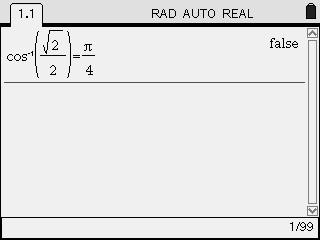Knowledge Base
Solution 26790: Troubleshooting Equivalent Expressions Giving Different Answers on the TI-Nspire™ Family Handheld and Computer Software.
Why does my TI-Nspire handheld and computer software return a different "True/False" statement to equivalence tests than my TI-Nspire CAS handheld and computer software?
When using the TI-Nspire family handheld and computer software to test the equivalence of two numeric expressions, if the numeric expressions are indeed equal to each other, the TI-Nspire family handheld and computer software will usually return a "true" statement. However, in the case of trying to test the equivalence of irrational numeric expressions, the TI-Nspire handheld and computer software may return a "false" statement while the TI-Nspire CAS handheld and computer software may return a "true" statement.
This is due to the floating-point arithmetic used to approximate values on the TI-Nspire family handheld and computer software (also known as a "rounding error"). For example:
arccosine(square root(2)/2) = p/4
If the user tries to test the equivalence of these numeric expressions using the TI-Nspire handheld and computer software, the device will return a "false" statement even though both expressions are equal to each other. Using floating-point arithmetic, the numeric expressions may differ by as little as 1E-13 (1*10^-13) or .0000000000001 which is why the TI-Nspire handheld and computer software will return the "false" statement. A visual demonstration can be seen below:

Since the TI-Nspire CAS handheld and computer software do not use floating-point arithmetic to evaluate numeric expressions, these devices can be used to test the equivalence of irrational numeric expressions. A visual demonstration can be seen below:

In summary, Texas Instruments does not recommend using the TI-Nspire handheld and computer software to test the equivalence of irrational numeric expressions since it is impossible to guarantee that equivalent expressions will approximate to the exact same floating-point value.
For more information, please see the TI-Nspire Family Guidebooks.
